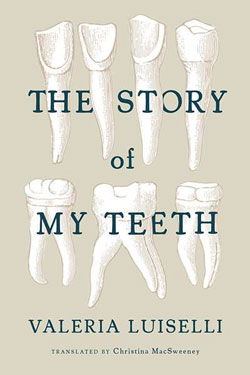The Story of My Teeth
by Valeria Luiselli
reviewed by Gabriel García Ochoa
Menippean satire is a strange and complex beast, difficult to pin down. The genre derives its name from the classic satirist Menippus of Gadara, whose oeuvre is now lost. Some refer to Menippean satire as an “anti-genre” rather than a genre. It is differentiated from other forms of satire mostly by its scholarly nature; while densely intellectual, Menippean satire uses its erudition to make fun of the frivolity of learning. It is self-parodying, protean, and devilishly difficult to write. A good example by a Latin American writer is Carlos Fuentes’s Christopher Unborn (Cristóbal Nonato); another more recent but equally brilliant one is The Story of My Teeth by his fellow Mexican, Valeria Luiselli.
Like Fuentes, Luiselli is the daughter of diplomats. She grew up in South Africa and has lived in France, India, Spain, Costa Rica, and South Korea. Unlike Luiselli, who is now based in New York, the main character in The Story of My Teeth lives in Mexico City. Gustavo Sánchez Sánchez, a.k.a. “Highway,” claims to be the best auctioneer in the world. According to Highway, he can auction anything and everything: cars, furniture, jewelry. At one point in The Story of My Teeth, he even auctions himself. Highway wants to make enough money to get his teeth fixed because he believes that “the teeth are the true windows to the soul,” and one night, at an auction in Little Havana, he buys a set of teeth that he intends to have surgically implanted. These teeth, “sacred, graceful and hallowed as Bernini’s St. Peter’s Colonnade,” belonged to none other than Marilyn Monroe.
Luiselli’s novel is full of high and lowbrow references, another characteristic of Menippean satire. For example, Highway is in the habit of quoting lyrics from 1970s Mexican pop singer Napoleon, and one of his auctioneering teachers was Leroy Van Dyke. His relatives present an ample catalogue of literary allusions, including his uncles Marcelo Sánchez-Proust, Fredo Sánchez Dostoyevksy, and his cousin Juan Pablo Sánchez Sartre, who keeps telling his family and friends that they are hell.
Highway conducts only one auction in the novel, during a passage that forms part of Luiselli’s overall commentary on the value of art and the commodification of narrative. Philosophical discussions such as these are another important element of Menippean satires, what Bakhtin calls “the dialogic search for truth.” Highway’s maxim as an auctioneer is that the value of objects emanates from their stories. He decides to auction his original teeth, the ones he had replaced with Marilyn Monroe’s, but he passes them off as the teeth of ten “infamous” characters he admires: Petrarch, Enrique Vila-Matas, Charles Lamb, Rousseau, Borges, St. Augustine, Chesterton, Plato, Woolf, and Montaigne. And Highway does not believe he is lying when he attributes these teeth to jaws other than his own. To him, his apocryphal tales merely provide us with “an elegant surpassing of the truth.” At the end of the day, what he is really selling are the stories he makes up.
“Places and things are made up of stories,” Highway tells us, and The Story of My Teeth is no exception. The story of The Story of My Teeth is in itself remarkable, inviting us to reflect on its own self-parodying nature. As the acknowledgements explain, the book began as a catalog for an art exhibition that took place in a gallery located next to a juice factory in Mexico City. Both the factory and gallery are owned by canned juice behemoth Grupo Jumex. Bringing together two literary traditions of the nineteenth century—the serialized novel and the lectores de tabaquería (“tobacco readers,” who read aloud to workers in Cuban factories as the latter made cigars), the book was written in installments and sent to the the factory workers at Jumex from New York every week. Later, during after-hours reading group sessions at the factory, the book was discussed. Luiselli requested that these sessions to be recorded and sent to her every week; based on the workers’ comments, she planned the next installment. Luiselli sees her novel as a collaborative text and acknowledges the role that the workers had in writing the book, just as she acknowledges the prominent role of her translator, Christina MacSweeney.
According to Luiselli, the English translations of her books (she has published two others, Sidewalks and Faces in the Crowd) ought to be seen as versions of the text rather than translations. The last chapter of the English translation of The Story of My Teeth is an interesting commentary on the role of the translator in contemporary literature. Entitled “The Chronologic,” the chapter was written entirely by MacSweeney. It is a timeline, a pastiche, and a glossary of the many tangential stories gravitating around the story of Highway’s life. The archaic maxim that a good literary translation should be as clear and transparent as a pane of glass, effacing the presence of the translator, is completely obliterated by MacSweeney’s chapter. Are the myriad tales affixed to Highway’s story meant to add value to it? Does the story of the factory workers’ collaboration, and MacSweeney’s chapter, make Luiselli’s novel more marketable? Perhaps, but this detracts not one iota from the literary value of The Story of My Teeth.
Published on January 8, 2016

